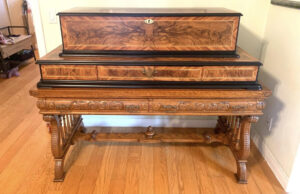 JMC sent me photos of a fantastic music box, probably fifty to sixty inches long and twenty-five to thirty inches wide, dating from the late 19th century. I LOVE old mechanical music boxes because they send me to another era hearing that brilliant resonant tone. This box contains five cylinders. Each cylinder plays a few songs, about six, generally well known tunes. Examples include The Star Spangled Banner, as well as opera arias Maritana, Aida, Barbier, Rigoletto, and La Norma. People considered those songs popular when a well-to-do family installed this music box in their front parlor circa 1885- 1895.
JMC sent me photos of a fantastic music box, probably fifty to sixty inches long and twenty-five to thirty inches wide, dating from the late 19th century. I LOVE old mechanical music boxes because they send me to another era hearing that brilliant resonant tone. This box contains five cylinders. Each cylinder plays a few songs, about six, generally well known tunes. Examples include The Star Spangled Banner, as well as opera arias Maritana, Aida, Barbier, Rigoletto, and La Norma. People considered those songs popular when a well-to-do family installed this music box in their front parlor circa 1885- 1895.
Guests Gathered Around the Music Box
Picture a small Sunday gathering of friends and family in that parlor. This box sat on a custom table in the center of the room or perhaps against one wall. The room overfilled with overstuffed comfortable seating, antimacassars on chair headrests, matching pouf ottoman(s) for the feet. Potted palms in heavy red glazed earthenware pots grace each corner. The heavy burgundy and olive striped velvet drapes darken the room at 2 pm, closed after your servants cleared away dinner, served mid-day back them. Your portly, bewhiskered husband cranks up the music box so for your guests to hear a small selection of its available tunes.
Since your guests join your family most Sundays, they’ve heard the same songs, arranged the same way, played on the music box many times before. The guests sat, enraptured, and listened to the tunes as if at a concert. They didn’t see this music as background music, no such concept existed. They listened with real respect and fascination to the ONLY semi-live entertainment available.
Music Box Metal Maker’s Marks
This is a Sublime Harmonie Paillard Company Swiss music box, and extremely rare. The label states the box is a Longue Marche which plays for at least two hours with a good crank. If I see the photo correctly, this ‘Quator’ contains five cylinders, and possibly storage for others in the supporting table below. More than one cylinder seemed rather rare, and extremely pricey in the day. Paillard offered a popular model with one cylinder. It played the same songs for two and a half hours, running on a large spring, called a “dinner box.” You could listen during dinner without leaving the table to crank it.
Another “period” feature of the late 1890s dictated hiding the advanced mechanical features for the time. Today we relish precision workings and want to see them, and show them as a design concept. In 1890 good taste meant wonderful mechanisms housed in a inlaid marquetry box of great beauty, resembling a massive jewel box in earlier eras. The machinery wasn’t the bragging point.
The Mechanics Inside
These music boxes played from a series of teeth, flexible spring steel strips rigidly held in place at one end, plucked on the other. Pitch and tone modulation happened via weight and width. Pre 1800s boxes have these little teeth individually screwed down on the support. 1840s boxes have sectional combs where teeth in sections are screwed in a support. In the 1870s David Le Coultre invented the solid comb, a one piece continuum with multiple teeth in a single support. All music boxes needed a damper, called a feather damper. If the music required a note played twice in succession, the vibration from the first “pluck” caused the second “pluck” to emit a harsh grating sound. I suspect JMC’s box uses top of the line dampers.
The movements inside the beautiful cases, elegant but mainly hidden, were nickel plated with massive springs that drove a five and three-quarters inch wheel, a butterfly governor and speed moderator, and stops for safety checks and stops to protect the great wheel. Aside from clockmaking, it took the Swiss to make this premiere music box.
Collectors for these boxes don’t lay back to listen on a Sunday after dinner. They collect them for their evocation of the elegantly eccentric, comfort and outwardly beauty-loving era we call by both the Belle Epoch, the beautiful Ten Years, and the Beaux Arts Era. Both evoke the same meaning. The music box is worth at least $20,000.